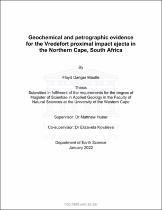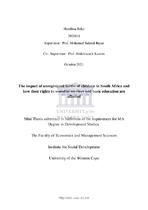| dc.contributor.advisor | Huber, Matthew | |
| dc.contributor.author | Mautle, Danger | |
| dc.date.accessioned | 2023-07-13T14:10:21Z | |
| dc.date.available | 2023-07-13T14:10:21Z | |
| dc.date.issued | 2022 | |
| dc.identifier.uri | http://hdl.handle.net/11394/10391 | |
| dc.description | >Magister Scientiae - MSc | en_US |
| dc.description.abstract | The advancement of the understanding of hypervelocity impacts lies in discovering impact structures and both proximal and distal impact ejecta. This study uses petrographic and geochemical techniques to investigate the occurrence of Vredefort proximal impact ejecta in the Paleoproterozoic Maremane Dome, South Africa. Anomalous spherical objects ca. 15 mm in apparent diameter have been observed near the top of the Doornfontein Conglomerate Member in the Maremane Dome, South Africa. The objects were previously described as pisolites formed by laterization. The Doornfontein Conglomerate Member was thought to be a conglomerate unit formed by erosion and karstification of the Maremane Dome during the tectonic uplift. However, these interpretations appear to not fully explain most observations in the Doornfontein Conglomerate Member and anomalous objects and are therefore a concern. | en_US |
| dc.language.iso | en | en_US |
| dc.publisher | University of the Western Cape | en_US |
| dc.subject | Hypervelocity meteorite impact events | en_US |
| dc.subject | Vredefort ejecta | en_US |
| dc.subject | Impact accretionary lapilli | en_US |
| dc.subject | Vredefort impact structure | en_US |
| dc.subject | Proximal impact ejecta | en_US |
| dc.title | Geochemical and petrographic evidence for the vredefort proximal impact ejecta in the Northern Cape, South Africa | en_US |
| dc.rights.holder | University of the Western Cape | en_US |




